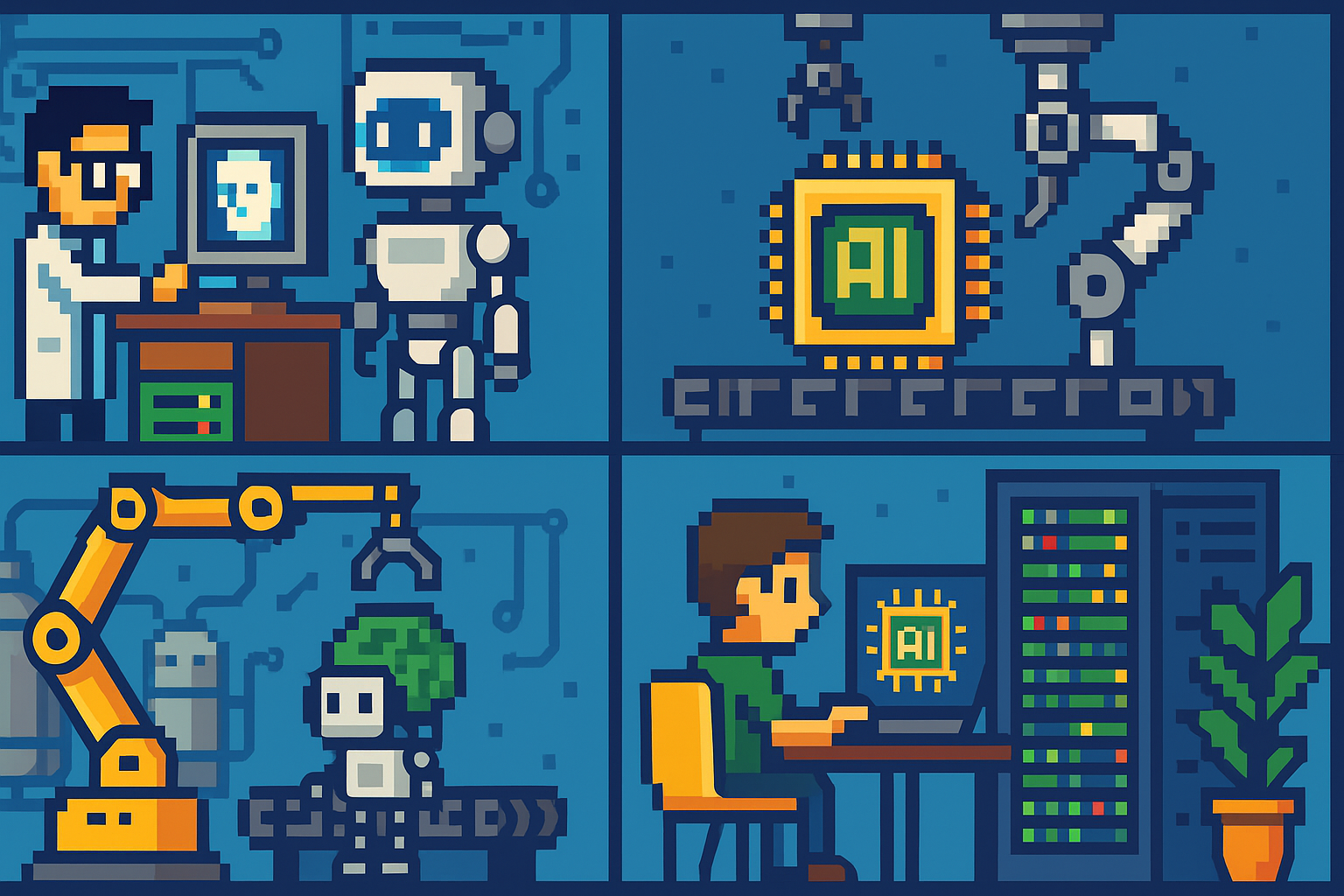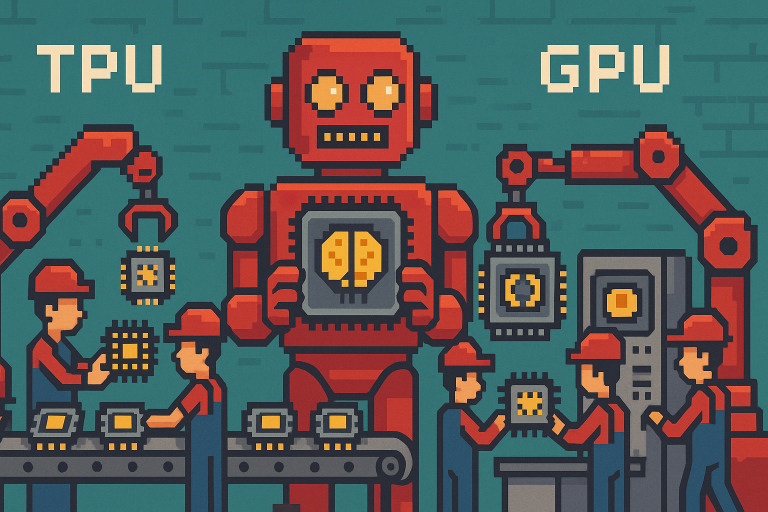The Magnificent 7 are expensive, cash-burning AI believers trading at 31-40x free cash flow while promising returns that might not materialize. A better bet is the companies selling them the shovels – the AI Infrastructure Compounders 7 (AIC-7), who are generating cash today while the hyperscalers burn through $417 billion this year alone.
The Magnificent 7 Today: Who’s Actually Making Money?
The AI gold rush is real. Microsoft, Google, Amazon, and Meta will collectively spend about $417 billion on AI infrastructure in 2025, up 64% from last year, with another jump to roughly $505 billion in 2026. That’s half a trillion dollars betting that AI will eventually pay for itself.
But here’s the problem: most of that spending hits the income statement as depreciation before it generates a single dollar of revenue. It’s like building a factory that costs billions while hoping customers show up later.
Apple: The Services Machine With an AI Problem
Apple just posted record Services revenue of $27.4 billion (up 13% year-over-year) while iPhone and Mac grew double-digits. Company gross margins are guided at 46-47%, with Services hitting 75.6%. The cash generation is absurd – $27.9 billion in operating cash flow in the June quarter alone, with net cash around $34.7 billion.
The issue? Apple is barely investing in AI capex compared to everyone else. Their bet is on-device AI inside the ecosystem with gradual Services monetization. That works if you believe the iPhone remains sticky. It doesn’t work if AI moves the computing experience elsewhere. At 32x free cash flow against high-single-digit growth, you’re paying for a future that might not arrive.
Microsoft: Quality at a Premium
Azure grew 39% year-over-year in Q4 fiscal 2025, with Q1 guidance at 37% constant currency. Cloud gross margins are 69%, down from last year because they’re scaling AI infrastructure. Q4 capex hit $24.2 billion; Q1 will exceed $30 billion.
The saving grace? Microsoft explicitly ties capex to contracted backlog ($368 billion), meaning they’re not building capacity on speculation. When inference ramps, revenue should follow capex with better correlation than peers. Q4 free cash flow was $25.6 billion. At 31x free cash flow with ~11% growth, you’re paying fair value for quality compounding, but there’s no margin of safety.
Alphabet: Growth at a Discount (Finally)
Services revenue grew 12% year-over-year while Cloud backlog hit $106 billion, tight through 2026. Operating margins are 32% with rising depreciation from AI buildout. The company raised 2025 capex guidance to approximately $85 billion, with 2026 expected higher. Trailing twelve-month free cash flow is $66.7 billion on $95 billion in cash and securities.
The DOJ remedy ruling largely preserved default search placement economics, removing a multi-year overhang. At 31x free cash flow with 16% growth expectations and positive legal resolution, Alphabet shows the best value proposition in the Mag 7. DCF analysis under reasonable assumptions supports current levels, and the P/E ratio sits near the lower end of peer comparisons.
Amazon: The Backlog Is Real
AWS grew 17.5% year-over-year while triple-digit AI demand remains supply-constrained. AWS margin compressed from 39.5% to 32.9% quarter-over-quarter on stock-based compensation and higher depreciation. Cash capex hit $31.4 billion in Q2, with elevated run-rates continuing into the second half of 2025.
Amazon has large AWS performance obligations (approximately $189 billion), suggesting attractive long-term ROI on infrastructure even as depreciation pressures near-term margins. At 35.9x free cash flow with 20% growth, the multiple is steep but the backlog visibility is real. If they can convert that pipeline without margin collapse, Amazon works.
Meta: Priced for Perfection
Revenue grew 22% year-over-year with Q2 operating margins at 43%. Fiscal 2025 capex guidance is $66-72 billion, with another large step-up in 2026 for GenAI capacity. Q2 free cash flow was $8.5 billion on $47.1 billion cash and $28.8 billion debt.
Management cites “compelling returns” from AI capacity into core ads, and there’s evidence that ad monetization is improving from AI optimization. The problem? At 40x free cash flow with ~11.5% growth, you’re paying for margin expansion that might not come – 2026 will skew toward depreciation rather than margin improvement as AI assets enter service. If the AI ad uplift disappoints, there’s no cushion.
NVIDIA: The Ecosystem King
Q2 fiscal 2026 revenue hit $46.7 billion with Data Center up 56% year-over-year. GB300 shipments began, driving the next product cycle. Non-GAAP gross margins run 72-73%, targeting mid-70s. The company authorized a $60 billion buyback while funding the fastest product ramps in its history.
At roughly 32x forward P/E (earnings yield around 3.1%), NVIDIA trades below its 9-year median despite framing a $3-4 trillion decade-long AI infrastructure opportunity. The ecosystem moat is real, NVIDIA owns training and inference with 75%+ networking attach rates. The risk is concentration: if AI capex digests or China export controls tighten or China starts approaching NVIDIA in their technological prowess (think Huawei), the revenue cliff is steep. Base case IRR is 26%, but the execution dependency is total.
Tesla: A Car Company Trading Like a Tech Stock
Auto revenue declined year-over-year. Q2 operating margin was 4.1% with auto gross margins ex-credits around 14.4%. The company guides 2025 capex above $9 billion for AI compute and manufacturing. Q2 free cash flow was $146 million, basically nothing.
The bull case is FSD/robotaxi and robotics, but those are long-dated bets with opex and depreciation rising now. At 176-246x forward P/E, you’re paying venture capital prices for a manufacturing business with cyclical exposure and minimal current cash generation. Expected 3-5 year IRR is roughly 5%, with -10% downside risk if the autonomy story breaks. This is speculation, not investment.
Valuation Reality Check: What Are You Actually Paying For?
Let’s cut through the noise. Expected returns over 3-5 years roughly equal normalized FCF yield + sustainable growth – multiple contraction.
Here’s where the Mag 7 stands on CY26 estimates:
The Decent Bets:
- NVIDIA: ~3.1% yield, 26% growth, some multiple compression risk = 26% expected return
- Amazon: 2.8% yield, 20% growth, stable multiples = 23% expected return
- Alphabet: 3.2% yield, 16% growth, modest re-rating potential = 20% expected return
The Middling Plays:
- Microsoft: 3.2% yield, 11% growth, slight compression = 13% expected return
- Meta: 2.5% yield, 11.5% growth, compression risk = 12% expected return
The Questionable Investments:
- Apple: 3.1% yield, 9% growth, multiple compression = 10% expected return
- Tesla: <1% yield, 7% growth, meaningful compression = 5% expected return
You’re buying NVIDIA and Amazon for growth at reasonable prices. You’re buying Alphabet for quality at a discount. You’re buying Microsoft for compounding at fair value. You’re buying Apple and Meta at valuations that require perfect execution. You’re gambling on Tesla.
The PEG ratios tell the story: NVIDIA at 1.2x, Amazon at 1.8x, Alphabet at 1.9x are defensible. Microsoft at 2.8x, Meta at 3.5x, and Apple at 3.5x assume nothing goes wrong. Tesla above 14x PEG is delusional.
What Could Actually Go Wrong
For NVIDIA: AI demand swings ±20% affect revenue ±25% and gross margin ±300 basis points. China export controls put 15-20% of revenue at risk, worth roughly 500 basis points to IRR. Total swing: ±8-10% on expected returns.
For Microsoft: Azure growth moves ±500 basis points, depreciation ±300 basis points. Minimal direct regulatory impact. IRR impact: ±3-5%.
For Alphabet: The remedy ruling largely preserves search economics (+200 basis points if resolved fully favorably). IRR impact: ±3-5%.
For Amazon: AWS growth ±400 basis points, margin ±400 basis points; depreciation timing affects 2025-26 FCF significantly. IRR impact: ±4-6%.
For Meta: Ad revenue ±200 basis points affects FCF by ±$10 billion. EU DMA costs run ~5-8% of EU revenue (approximately $2-3 billion annually). IRR impact: ±3-4%.
For Apple: Services growth ±100 basis points (relatively insulated). App Store fee pressure could hit Services margins by 200-300 basis points. IRR impact: ±1-2%.
For Tesla: Auto volume ±200 basis points (macro-sensitive). Tariff exposure hits auto margins by 200-400 basis points. IRR impact: ±2-3%, though the range is wider given the cyclical exposure.
The Better Alternative: AI Infrastructure Compounders 7 (AIC-7)
Here’s the fundamental insight: if hyperscalers are burning through $417 billion in 2025 rising to $505 billion in 2026, someone is collecting that money with better visibility than the hyperscalers themselves.
The companies selling picks and shovels to the AI gold rush have three advantages:
- They’re generating cash today, not reinvesting ahead of uncertain monetization
- They have contracted visibility through backlogs, RPOs, and installed-base service revenue
- They don’t depend on end-application monetization – if Microsoft’s Copilot flops, ASML still ships EUV machines
The Portfolio: Seven Companies at AI Chokepoints
ASML (16% weight)
EUV monopoly with 2Q25 bookings up ~40% quarter-over-quarter to €5.5 billion. Trades at ~27x P/E, more than 10% below 3-year average. Rising dividend and buyback framework. Base IRR: 14-16%.
The only company on earth that can make the machines that make leading-edge semiconductors. Every AI chip that matters runs through ASML’s technology. When hyperscalers expand capacity, ASML gets paid first.
Broadcom (18% weight)
AI semiconductor revenue hit $5.2 billion in FQ3, guided to $6.2 billion in FQ4. Record quarterly free cash flow of approximately $7.0 billion. FY26 earnings ramp lowers headline P/E from mid-40s toward high-20s as scale kicks in. Base IRR: 15-18%.
Broadcom is building custom ASICs for the hyperscalers, the silicon that sits alongside NVIDIA GPUs for specialized workloads. The TAM is enormous and Broadcom owns the design expertise.
TSMC (18% weight)
Leading-edge economics intact with Q4 2024 gross margin at 59%, operating margin at 49%. 2025 capex $38-42 billion with 10-20% directed to advanced packaging. CoWoS (chip-on-wafer-on-substrate) footprint expanding into 2026. Base IRR: 12-16%.
Every cutting-edge AI chip gets made at TSMC. The foundry advantage compounds through advanced packaging – the capability that lets you stick memory and compute together at performance levels competitors can’t match. When NVIDIA, AMD, or Broadcom designs the next generation, TSMC manufactures it.
Applied Materials (14% weight)
FQ3’25 free cash flow approximately $2.05 billion with commitment to distribute 80-100% of FCF. Advantaged at gate-all-around transistors, backside power delivery, HBM, and advanced packaging. Base IRR: 12-15%.
The deposition and etch equipment that makes leading-edge nodes possible comes from Applied Materials. As transistors get more complex (GAA) and memory gets stacked higher (HBM), Applied’s tools become more valuable. They’re printing cash and returning it to shareholders while competitors struggle.
KLA (12% weight)
FY25 revenue up 24% to $12.2 billion, record free cash flow $3.75 billion with ~31% FCF margin. Service revenue exceeds 75% recurring, “subscription-like” model. Base IRR: 13-16%.
Process control and metrology (measuring what you made to make sure it works) is where KLA dominates. As chips get more complex, inspection intensity rises. And because KLA owns the installed base, service revenue compounds like a subscription business. You don’t switch metrology vendors; you buy more KLA tools.
Oracle (12% weight)
Remaining performance obligations (RPO) surged to approximately $455 billion. Oracle Cloud Infrastructure (OCI) targeted to grow ~77% to approximately $18 billion in FY26 on signed multi-year contracts. FY26 capex plan ~$35 billion to fulfill demand. Base IRR: 14-17%.
Oracle is building out cloud capacity on multi-year contracts from enterprises who want AI but don’t want to go to AWS. The RPO number is real – $455 billion of contracted future revenue. They’re investing heavily now but with signed commitments, not hope.
Dell (10% weight)
H1 FY26 AI server shipments reached $10 billion; FY26 guidance raised to $20 billion. Generated $2.5 billion operating cash in Q2. Base IRR: 10-14%.
Dell assembles AI servers – high-revenue, decent-margin infrastructure sales to enterprises who need compute but lack hyperscaler scale. The $20 billion AI server business is real and growing, and Dell has the supply chain and customer relationships to capture it. This is the least compelling position in the portfolio, but the cash generation and enterprise exposure add diversification.
Why AIC-7 Beats Mag 7 on Risk-Adjusted Returns
Expected portfolio return: 12-18% from FCF yield of 3-5% plus organic cash growth of 9-13% as semiconductor equipment stabilizes into 2026-27 and cloud infrastructure contracts convert to revenue.
Compare this to the Mag 7 range of 5-26% where half the names deliver mid-teens or worse.
Downside protection is structural:
- Contracted visibility: ASML’s backlog is real, Oracle’s $455B RPO is committed spend, KLA’s service revenue is recurring. These are signed contracts.
- Installed-base economics: Once you buy an ASML EUV machine or KLA metrology tools, you’re locked in. Service attach and upgrades compound without re-selling.
- Diversification across the stack: Tools (ASML, Applied, KLA), foundry (TSMC), custom silicon (Broadcom), cloud capacity (Oracle), and system integration (Dell). One bottleneck easing means another tightens – you’re covered across the entire AI build-out.
Cash generation today vs. tomorrow:
Broadcom generated ~$7.0 billion in free cash flow in a single quarter. Applied Materials did ~$2.05 billion in FQ3. KLA operates at ~31% FCF margins. These companies are collecting the AI build-out spend now, while the Mag 7 reinvest ahead of monetization that might never come.
If Copilot adoption disappoints, Microsoft’s capex turns into a sunk cost. If that happens, ASML and Broadcom already got paid. That’s the difference between selling picks and hoping to strike gold versus hoping the gold is there.
What Could Go Wrong With AIC-7
The bear case isn’t trivial:
- AI capex digestion: If hyperscalers realize 30% of capacity sits idle, orders dry up immediately. Semiconductor equipment companies can drop 20-30% in a digestion cycle.
- China/tariff overhang: ASML and Applied Materials both have meaningful China exposure. Export controls could lock out 15-20% of revenue with no replacement TAM. Tariffs on components add cost.
- WFE cyclicality: Wafer fab equipment spending is brutal cyclically. If we’re at $100B in 2026 but then it drops to $80B in 2027-28, the pain is severe across ASML, Applied, and KLA.
- Oracle is really a Mag 7 bet in disguise: Oracle’s entire thesis depends on enterprises spending on AI. If AI capex disappoints, Oracle’s $35 billion FY26 build-out becomes a margin destroyer, not a growth engine. Including it in an “infrastructure” portfolio dilutes the thesis.
- Dell is low-margin assembly: AI servers are high-revenue, low-margin. Dell might hit $20 billion in AI server revenue but at thin profitability. Mixing a systems integrator with semiconductor toolmakers conflates different return profiles.
Downside scenario: -20% to -30% if AI spending pauses and semiconductor equipment orders roll over.
But compare that to the Mag 7 downside of -10% to +26% where Tesla can lose half its value if the robotaxi story breaks and Meta can drop 20% if 2026 depreciation kills margins without ad uplift.
The Honest Take
Neither portfolio is a slam dunk. The Mag 7 trades quality and end-market exposure for expensive valuations and reinvestment risk. The AIC-7 trades current cash generation and visibility for cyclical exposure and concentration risk.
The best portfolio is a barbell:
- From Mag 7: Alphabet and Amazon. Positive skew, reasonable valuations, diversified revenue streams, real backlogs. Skip Apple (too expensive), Meta (too much capex risk), Microsoft (fair value with no margin of safety), Tesla (speculation), and NVIDIA (own it through the infrastructure layer instead).
- From AIC-7: ASML, Broadcom, and TSMC. Genuine moats, durable cash, strategic chokepoints. Skip Oracle (it’s really a cloud play, not infrastructure), Dell (low-margin assembly), and KLA and Applied (good companies, but you don’t need five semiconductor equipment names).
Five stocks: GOOGL, AMZN, ASML, AVGO, TSM.
You get end-market exposure through Alphabet and Amazon, infrastructure exposure through ASML and Broadcom, and foundry economics through TSMC. The portfolio captures AI spend at every layer without forced diversification into weaker positions.
Rebalance quarterly, cap single names at 25%, and monitor the signposts: hyperscaler capex run-rates, HBM shipping cadence, TSMC CoWoS capacity additions, and AWS/GCP backlog burn rates. If AI capex rolls over, you’ll see it in bookings two quarters before it hits earnings.
The “AI Infrastructure Compounders 7” name sounds like someone needed to hit a number rather than build a portfolio. It should have been the “Infrastructure 5” or accepted that sometimes the right answer is six stocks, not seven.
But the core thesis, own the companies collecting the spend, not the ones burning it, is sound. The Mag 7 might win if AI monetization works perfectly. The AIC-5 wins if the build-out continues regardless of whether the applications ever pay for themselves.
This analysis is for educational purposes only and not personalized investment advice. Trading involves risk and may not be suitable for all investors.





